BTEC HND in Business: Management Accounting Systems & Techniques
VerifiedAdded on 2023/01/13
|17
|5148
|98
Report
AI Summary
This report delves into management accounting, defining it as a process that aids decision-making through financial data. It differentiates management accounting from financial reporting, highlighting its use by internal managers. The study assesses various aspects of management accounting, including its systems and reporting methods, within the context of Wow Fabrics, a leading UK clothing manufacturer. It demonstrates how management accounting tools can be applied in financial reporting, describes planning tools and their role in budgetary control, and compares how corporations adapt management accounting systems to address financial issues. The report covers cost accounting, inventory management, and job costing systems, along with an evaluation of different management accounting reports used by Wow Fabrics, such as cost accounting, inventory management, job costs, and performance reports. It also discusses the advantages and disadvantages of budgetary control planning tools and compares how corporations adapt management accounting systems to respond to financial challenges.
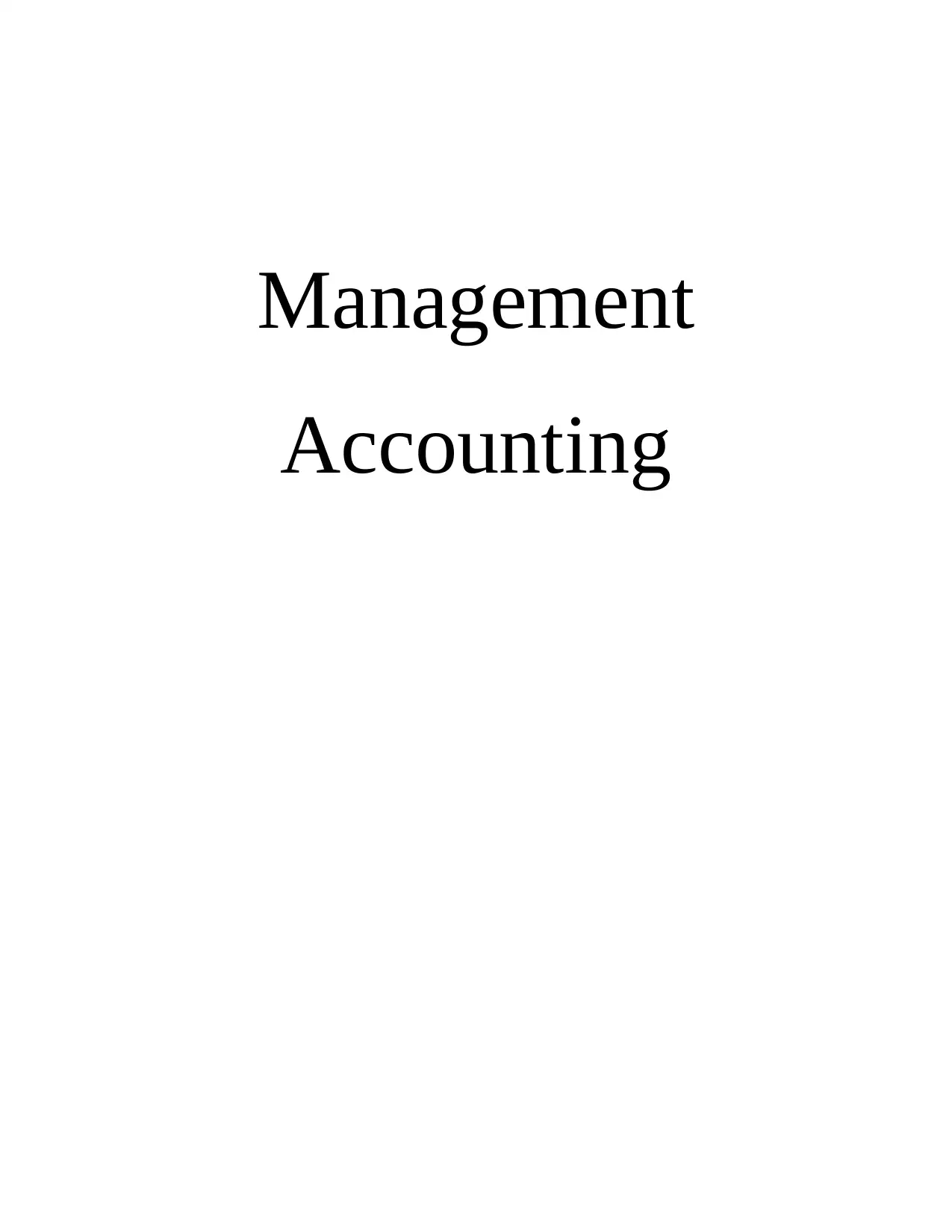
Management
Accounting
Accounting
Paraphrase This Document
Need a fresh take? Get an instant paraphrase of this document with our AI Paraphraser
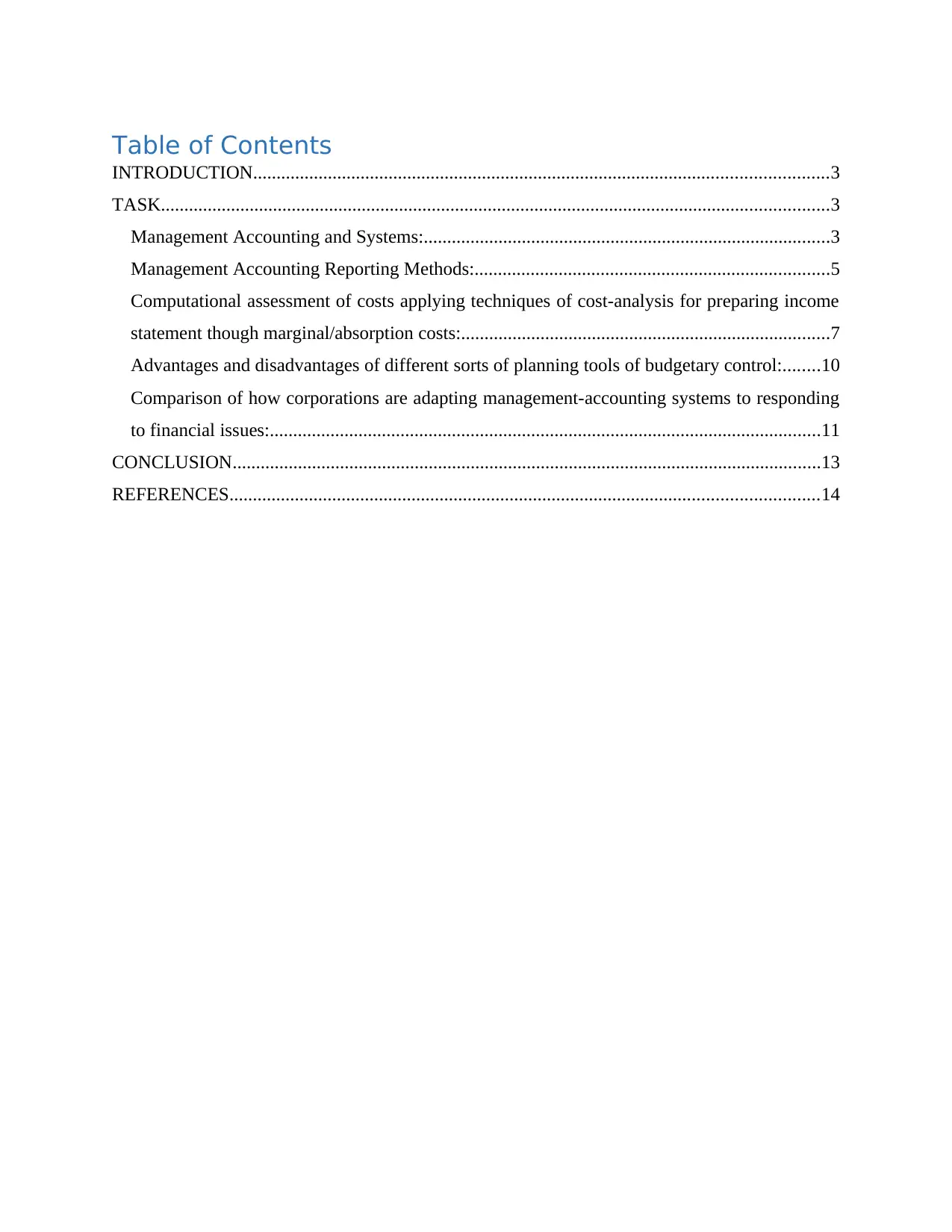
Table of Contents
INTRODUCTION...........................................................................................................................3
TASK...............................................................................................................................................3
Management Accounting and Systems:.......................................................................................3
Management Accounting Reporting Methods:............................................................................5
Computational assessment of costs applying techniques of cost-analysis for preparing income
statement though marginal/absorption costs:...............................................................................7
Advantages and disadvantages of different sorts of planning tools of budgetary control:........10
Comparison of how corporations are adapting management-accounting systems to responding
to financial issues:......................................................................................................................11
CONCLUSION..............................................................................................................................13
REFERENCES..............................................................................................................................14
INTRODUCTION...........................................................................................................................3
TASK...............................................................................................................................................3
Management Accounting and Systems:.......................................................................................3
Management Accounting Reporting Methods:............................................................................5
Computational assessment of costs applying techniques of cost-analysis for preparing income
statement though marginal/absorption costs:...............................................................................7
Advantages and disadvantages of different sorts of planning tools of budgetary control:........10
Comparison of how corporations are adapting management-accounting systems to responding
to financial issues:......................................................................................................................11
CONCLUSION..............................................................................................................................13
REFERENCES..............................................................................................................................14
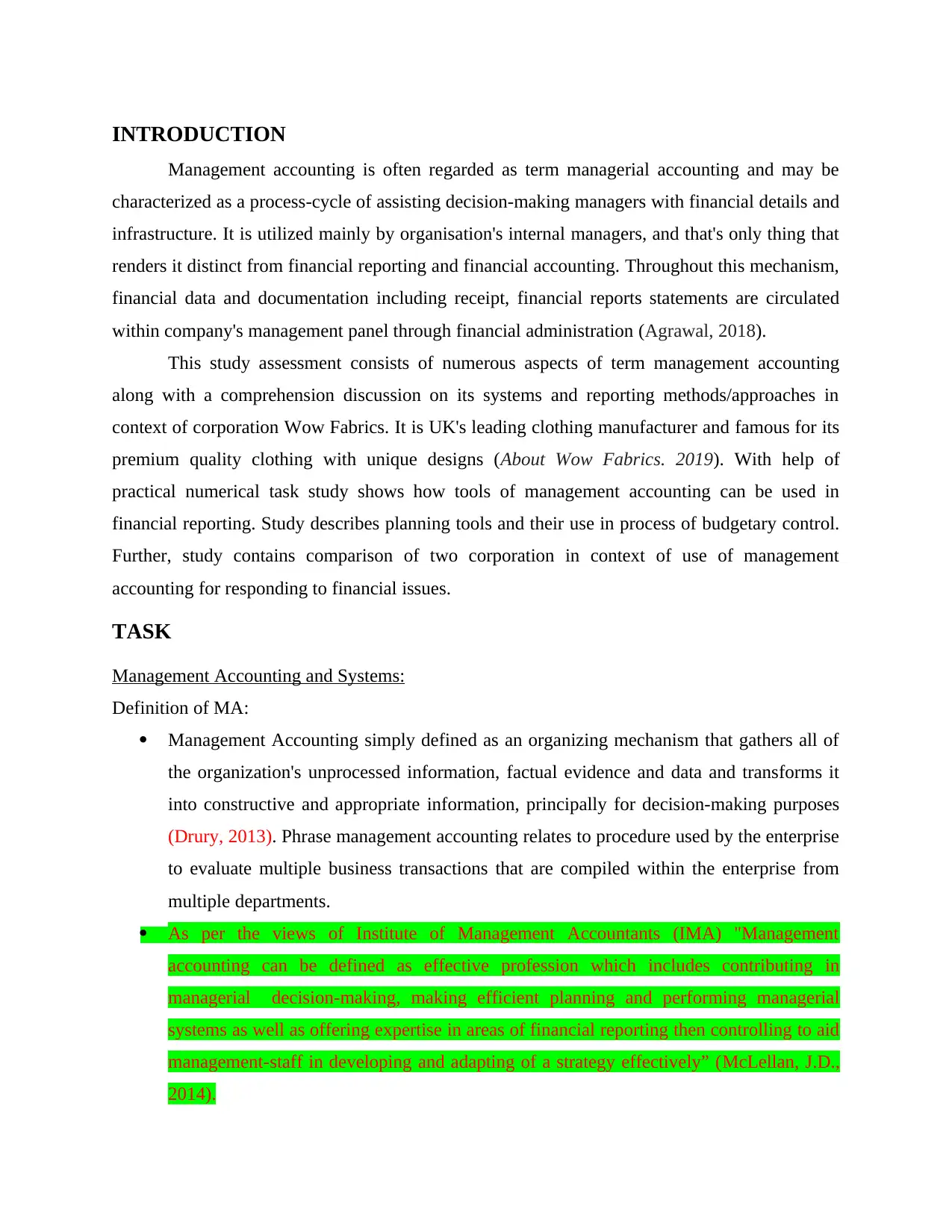
INTRODUCTION
Management accounting is often regarded as term managerial accounting and may be
characterized as a process-cycle of assisting decision-making managers with financial details and
infrastructure. It is utilized mainly by organisation's internal managers, and that's only thing that
renders it distinct from financial reporting and financial accounting. Throughout this mechanism,
financial data and documentation including receipt, financial reports statements are circulated
within company's management panel through financial administration (Agrawal, 2018).
This study assessment consists of numerous aspects of term management accounting
along with a comprehension discussion on its systems and reporting methods/approaches in
context of corporation Wow Fabrics. It is UK's leading clothing manufacturer and famous for its
premium quality clothing with unique designs (About Wow Fabrics. 2019). With help of
practical numerical task study shows how tools of management accounting can be used in
financial reporting. Study describes planning tools and their use in process of budgetary control.
Further, study contains comparison of two corporation in context of use of management
accounting for responding to financial issues.
TASK
Management Accounting and Systems:
Definition of MA:
Management Accounting simply defined as an organizing mechanism that gathers all of
the organization's unprocessed information, factual evidence and data and transforms it
into constructive and appropriate information, principally for decision-making purposes
(Drury, 2013). Phrase management accounting relates to procedure used by the enterprise
to evaluate multiple business transactions that are compiled within the enterprise from
multiple departments.
As per the views of Institute of Management Accountants (IMA) "Management
accounting can be defined as effective profession which includes contributing in
managerial decision-making, making efficient planning and performing managerial
systems as well as offering expertise in areas of financial reporting then controlling to aid
management-staff in developing and adapting of a strategy effectively” (McLellan, J.D.,
2014).
Management accounting is often regarded as term managerial accounting and may be
characterized as a process-cycle of assisting decision-making managers with financial details and
infrastructure. It is utilized mainly by organisation's internal managers, and that's only thing that
renders it distinct from financial reporting and financial accounting. Throughout this mechanism,
financial data and documentation including receipt, financial reports statements are circulated
within company's management panel through financial administration (Agrawal, 2018).
This study assessment consists of numerous aspects of term management accounting
along with a comprehension discussion on its systems and reporting methods/approaches in
context of corporation Wow Fabrics. It is UK's leading clothing manufacturer and famous for its
premium quality clothing with unique designs (About Wow Fabrics. 2019). With help of
practical numerical task study shows how tools of management accounting can be used in
financial reporting. Study describes planning tools and their use in process of budgetary control.
Further, study contains comparison of two corporation in context of use of management
accounting for responding to financial issues.
TASK
Management Accounting and Systems:
Definition of MA:
Management Accounting simply defined as an organizing mechanism that gathers all of
the organization's unprocessed information, factual evidence and data and transforms it
into constructive and appropriate information, principally for decision-making purposes
(Drury, 2013). Phrase management accounting relates to procedure used by the enterprise
to evaluate multiple business transactions that are compiled within the enterprise from
multiple departments.
As per the views of Institute of Management Accountants (IMA) "Management
accounting can be defined as effective profession which includes contributing in
managerial decision-making, making efficient planning and performing managerial
systems as well as offering expertise in areas of financial reporting then controlling to aid
management-staff in developing and adapting of a strategy effectively” (McLellan, J.D.,
2014).
⊘ This is a preview!⊘
Do you want full access?
Subscribe today to unlock all pages.

Trusted by 1+ million students worldwide
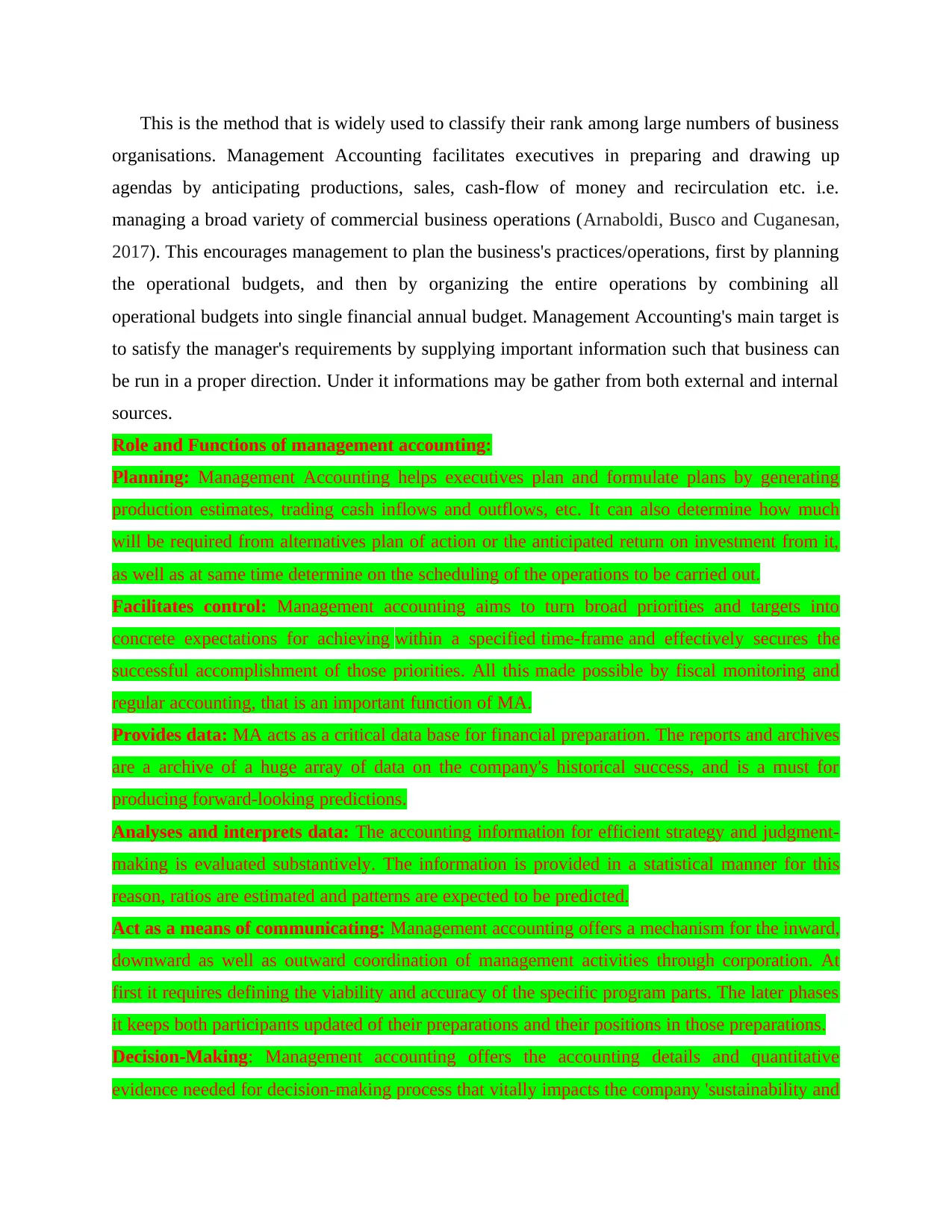
This is the method that is widely used to classify their rank among large numbers of business
organisations. Management Accounting facilitates executives in preparing and drawing up
agendas by anticipating productions, sales, cash-flow of money and recirculation etc. i.e.
managing a broad variety of commercial business operations (Arnaboldi, Busco and Cuganesan,
2017). This encourages management to plan the business's practices/operations, first by planning
the operational budgets, and then by organizing the entire operations by combining all
operational budgets into single financial annual budget. Management Accounting's main target is
to satisfy the manager's requirements by supplying important information such that business can
be run in a proper direction. Under it informations may be gather from both external and internal
sources.
Role and Functions of management accounting:
Planning: Management Accounting helps executives plan and formulate plans by generating
production estimates, trading cash inflows and outflows, etc. It can also determine how much
will be required from alternatives plan of action or the anticipated return on investment from it,
as well as at same time determine on the scheduling of the operations to be carried out.
Facilitates control: Management accounting aims to turn broad priorities and targets into
concrete expectations for achieving within a specified time-frame and effectively secures the
successful accomplishment of those priorities. All this made possible by fiscal monitoring and
regular accounting, that is an important function of MA.
Provides data: MA acts as a critical data base for financial preparation. The reports and archives
are a archive of a huge array of data on the company's historical success, and is a must for
producing forward-looking predictions.
Analyses and interprets data: The accounting information for efficient strategy and judgment-
making is evaluated substantively. The information is provided in a statistical manner for this
reason, ratios are estimated and patterns are expected to be predicted.
Act as a means of communicating: Management accounting offers a mechanism for the inward,
downward as well as outward coordination of management activities through corporation. At
first it requires defining the viability and accuracy of the specific program parts. The later phases
it keeps both participants updated of their preparations and their positions in those preparations.
Decision-Making: Management accounting offers the accounting details and quantitative
evidence needed for decision-making process that vitally impacts the company 'sustainability and
organisations. Management Accounting facilitates executives in preparing and drawing up
agendas by anticipating productions, sales, cash-flow of money and recirculation etc. i.e.
managing a broad variety of commercial business operations (Arnaboldi, Busco and Cuganesan,
2017). This encourages management to plan the business's practices/operations, first by planning
the operational budgets, and then by organizing the entire operations by combining all
operational budgets into single financial annual budget. Management Accounting's main target is
to satisfy the manager's requirements by supplying important information such that business can
be run in a proper direction. Under it informations may be gather from both external and internal
sources.
Role and Functions of management accounting:
Planning: Management Accounting helps executives plan and formulate plans by generating
production estimates, trading cash inflows and outflows, etc. It can also determine how much
will be required from alternatives plan of action or the anticipated return on investment from it,
as well as at same time determine on the scheduling of the operations to be carried out.
Facilitates control: Management accounting aims to turn broad priorities and targets into
concrete expectations for achieving within a specified time-frame and effectively secures the
successful accomplishment of those priorities. All this made possible by fiscal monitoring and
regular accounting, that is an important function of MA.
Provides data: MA acts as a critical data base for financial preparation. The reports and archives
are a archive of a huge array of data on the company's historical success, and is a must for
producing forward-looking predictions.
Analyses and interprets data: The accounting information for efficient strategy and judgment-
making is evaluated substantively. The information is provided in a statistical manner for this
reason, ratios are estimated and patterns are expected to be predicted.
Act as a means of communicating: Management accounting offers a mechanism for the inward,
downward as well as outward coordination of management activities through corporation. At
first it requires defining the viability and accuracy of the specific program parts. The later phases
it keeps both participants updated of their preparations and their positions in those preparations.
Decision-Making: Management accounting offers the accounting details and quantitative
evidence needed for decision-making process that vitally impacts the company 'sustainability and
Paraphrase This Document
Need a fresh take? Get an instant paraphrase of this document with our AI Paraphraser
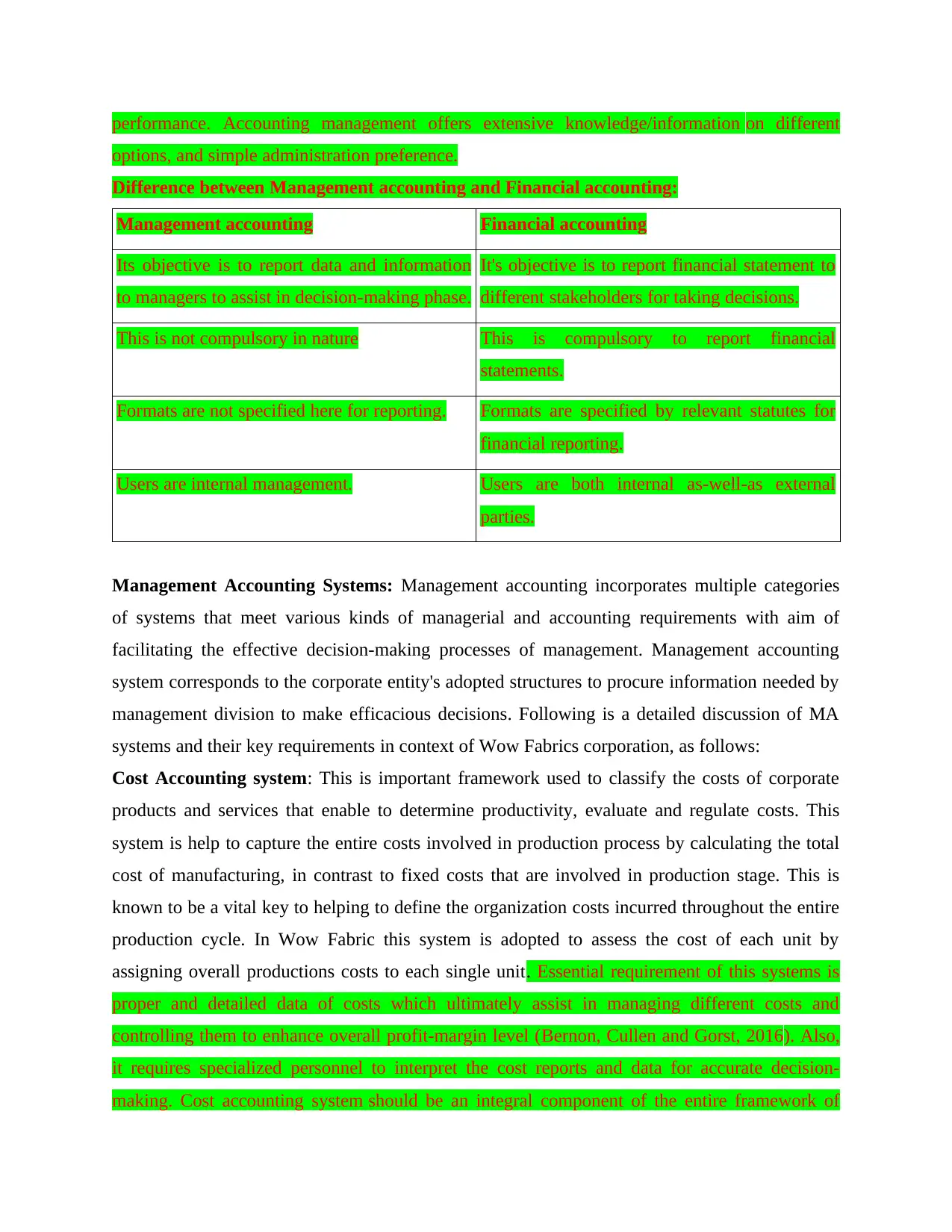
performance. Accounting management offers extensive knowledge/information on different
options, and simple administration preference.
Difference between Management accounting and Financial accounting:
Management accounting Financial accounting
Its objective is to report data and information
to managers to assist in decision-making phase.
It's objective is to report financial statement to
different stakeholders for taking decisions.
This is not compulsory in nature This is compulsory to report financial
statements.
Formats are not specified here for reporting. Formats are specified by relevant statutes for
financial reporting.
Users are internal management. Users are both internal as-well-as external
parties.
Management Accounting Systems: Management accounting incorporates multiple categories
of systems that meet various kinds of managerial and accounting requirements with aim of
facilitating the effective decision-making processes of management. Management accounting
system corresponds to the corporate entity's adopted structures to procure information needed by
management division to make efficacious decisions. Following is a detailed discussion of MA
systems and their key requirements in context of Wow Fabrics corporation, as follows:
Cost Accounting system: This is important framework used to classify the costs of corporate
products and services that enable to determine productivity, evaluate and regulate costs. This
system is help to capture the entire costs involved in production process by calculating the total
cost of manufacturing, in contrast to fixed costs that are involved in production stage. This is
known to be a vital key to helping to define the organization costs incurred throughout the entire
production cycle. In Wow Fabric this system is adopted to assess the cost of each unit by
assigning overall productions costs to each single unit. Essential requirement of this systems is
proper and detailed data of costs which ultimately assist in managing different costs and
controlling them to enhance overall profit-margin level (Bernon, Cullen and Gorst, 2016). Also,
it requires specialized personnel to interpret the cost reports and data for accurate decision-
making. Cost accounting system should be an integral component of the entire framework of
options, and simple administration preference.
Difference between Management accounting and Financial accounting:
Management accounting Financial accounting
Its objective is to report data and information
to managers to assist in decision-making phase.
It's objective is to report financial statement to
different stakeholders for taking decisions.
This is not compulsory in nature This is compulsory to report financial
statements.
Formats are not specified here for reporting. Formats are specified by relevant statutes for
financial reporting.
Users are internal management. Users are both internal as-well-as external
parties.
Management Accounting Systems: Management accounting incorporates multiple categories
of systems that meet various kinds of managerial and accounting requirements with aim of
facilitating the effective decision-making processes of management. Management accounting
system corresponds to the corporate entity's adopted structures to procure information needed by
management division to make efficacious decisions. Following is a detailed discussion of MA
systems and their key requirements in context of Wow Fabrics corporation, as follows:
Cost Accounting system: This is important framework used to classify the costs of corporate
products and services that enable to determine productivity, evaluate and regulate costs. This
system is help to capture the entire costs involved in production process by calculating the total
cost of manufacturing, in contrast to fixed costs that are involved in production stage. This is
known to be a vital key to helping to define the organization costs incurred throughout the entire
production cycle. In Wow Fabric this system is adopted to assess the cost of each unit by
assigning overall productions costs to each single unit. Essential requirement of this systems is
proper and detailed data of costs which ultimately assist in managing different costs and
controlling them to enhance overall profit-margin level (Bernon, Cullen and Gorst, 2016). Also,
it requires specialized personnel to interpret the cost reports and data for accurate decision-
making. Cost accounting system should be an integral component of the entire framework of
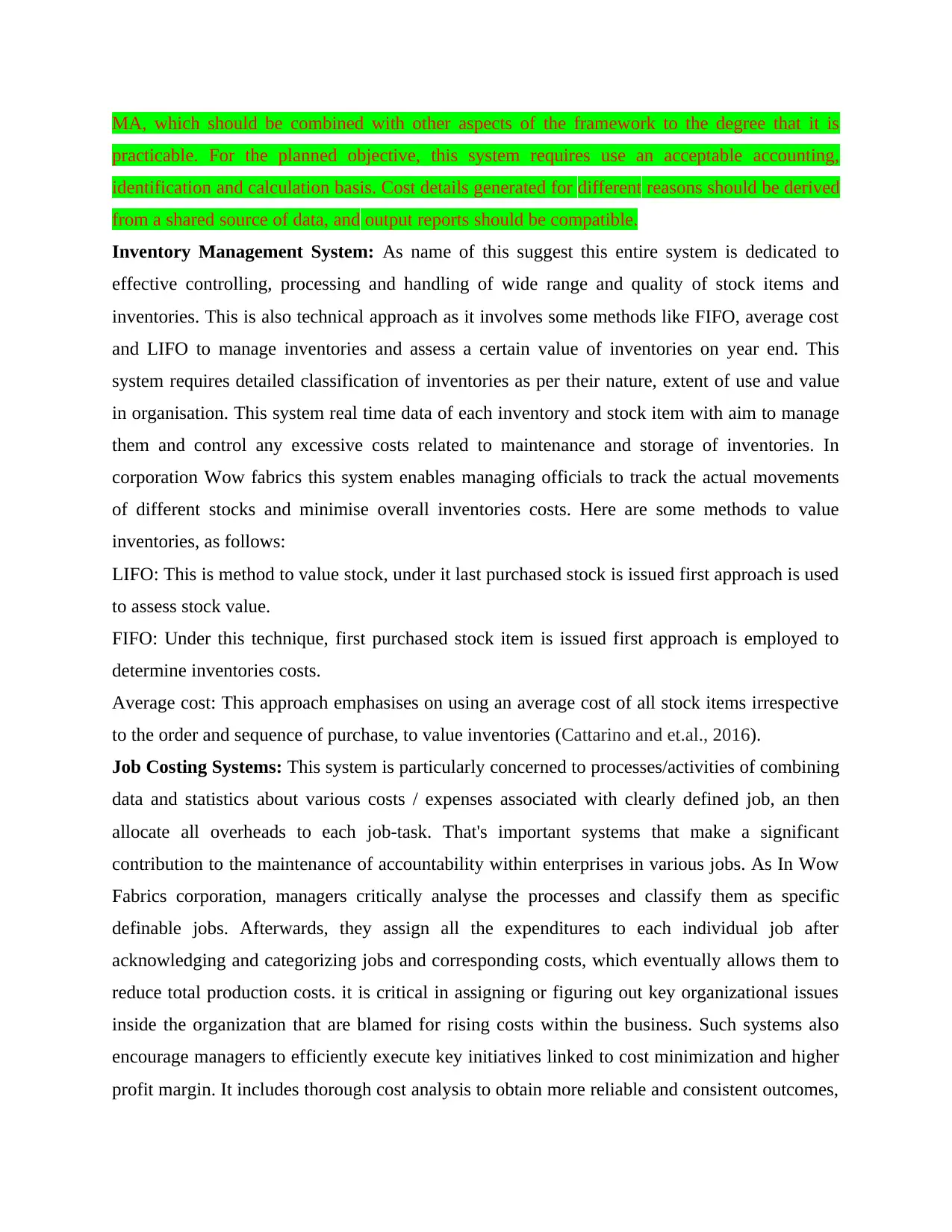
MA, which should be combined with other aspects of the framework to the degree that it is
practicable. For the planned objective, this system requires use an acceptable accounting,
identification and calculation basis. Cost details generated for different reasons should be derived
from a shared source of data, and output reports should be compatible.
Inventory Management System: As name of this suggest this entire system is dedicated to
effective controlling, processing and handling of wide range and quality of stock items and
inventories. This is also technical approach as it involves some methods like FIFO, average cost
and LIFO to manage inventories and assess a certain value of inventories on year end. This
system requires detailed classification of inventories as per their nature, extent of use and value
in organisation. This system real time data of each inventory and stock item with aim to manage
them and control any excessive costs related to maintenance and storage of inventories. In
corporation Wow fabrics this system enables managing officials to track the actual movements
of different stocks and minimise overall inventories costs. Here are some methods to value
inventories, as follows:
LIFO: This is method to value stock, under it last purchased stock is issued first approach is used
to assess stock value.
FIFO: Under this technique, first purchased stock item is issued first approach is employed to
determine inventories costs.
Average cost: This approach emphasises on using an average cost of all stock items irrespective
to the order and sequence of purchase, to value inventories (Cattarino and et.al., 2016).
Job Costing Systems: This system is particularly concerned to processes/activities of combining
data and statistics about various costs / expenses associated with clearly defined job, an then
allocate all overheads to each job-task. That's important systems that make a significant
contribution to the maintenance of accountability within enterprises in various jobs. As In Wow
Fabrics corporation, managers critically analyse the processes and classify them as specific
definable jobs. Afterwards, they assign all the expenditures to each individual job after
acknowledging and categorizing jobs and corresponding costs, which eventually allows them to
reduce total production costs. it is critical in assigning or figuring out key organizational issues
inside the organization that are blamed for rising costs within the business. Such systems also
encourage managers to efficiently execute key initiatives linked to cost minimization and higher
profit margin. It includes thorough cost analysis to obtain more reliable and consistent outcomes,
practicable. For the planned objective, this system requires use an acceptable accounting,
identification and calculation basis. Cost details generated for different reasons should be derived
from a shared source of data, and output reports should be compatible.
Inventory Management System: As name of this suggest this entire system is dedicated to
effective controlling, processing and handling of wide range and quality of stock items and
inventories. This is also technical approach as it involves some methods like FIFO, average cost
and LIFO to manage inventories and assess a certain value of inventories on year end. This
system requires detailed classification of inventories as per their nature, extent of use and value
in organisation. This system real time data of each inventory and stock item with aim to manage
them and control any excessive costs related to maintenance and storage of inventories. In
corporation Wow fabrics this system enables managing officials to track the actual movements
of different stocks and minimise overall inventories costs. Here are some methods to value
inventories, as follows:
LIFO: This is method to value stock, under it last purchased stock is issued first approach is used
to assess stock value.
FIFO: Under this technique, first purchased stock item is issued first approach is employed to
determine inventories costs.
Average cost: This approach emphasises on using an average cost of all stock items irrespective
to the order and sequence of purchase, to value inventories (Cattarino and et.al., 2016).
Job Costing Systems: This system is particularly concerned to processes/activities of combining
data and statistics about various costs / expenses associated with clearly defined job, an then
allocate all overheads to each job-task. That's important systems that make a significant
contribution to the maintenance of accountability within enterprises in various jobs. As In Wow
Fabrics corporation, managers critically analyse the processes and classify them as specific
definable jobs. Afterwards, they assign all the expenditures to each individual job after
acknowledging and categorizing jobs and corresponding costs, which eventually allows them to
reduce total production costs. it is critical in assigning or figuring out key organizational issues
inside the organization that are blamed for rising costs within the business. Such systems also
encourage managers to efficiently execute key initiatives linked to cost minimization and higher
profit margin. It includes thorough cost analysis to obtain more reliable and consistent outcomes,
⊘ This is a preview!⊘
Do you want full access?
Subscribe today to unlock all pages.

Trusted by 1+ million students worldwide
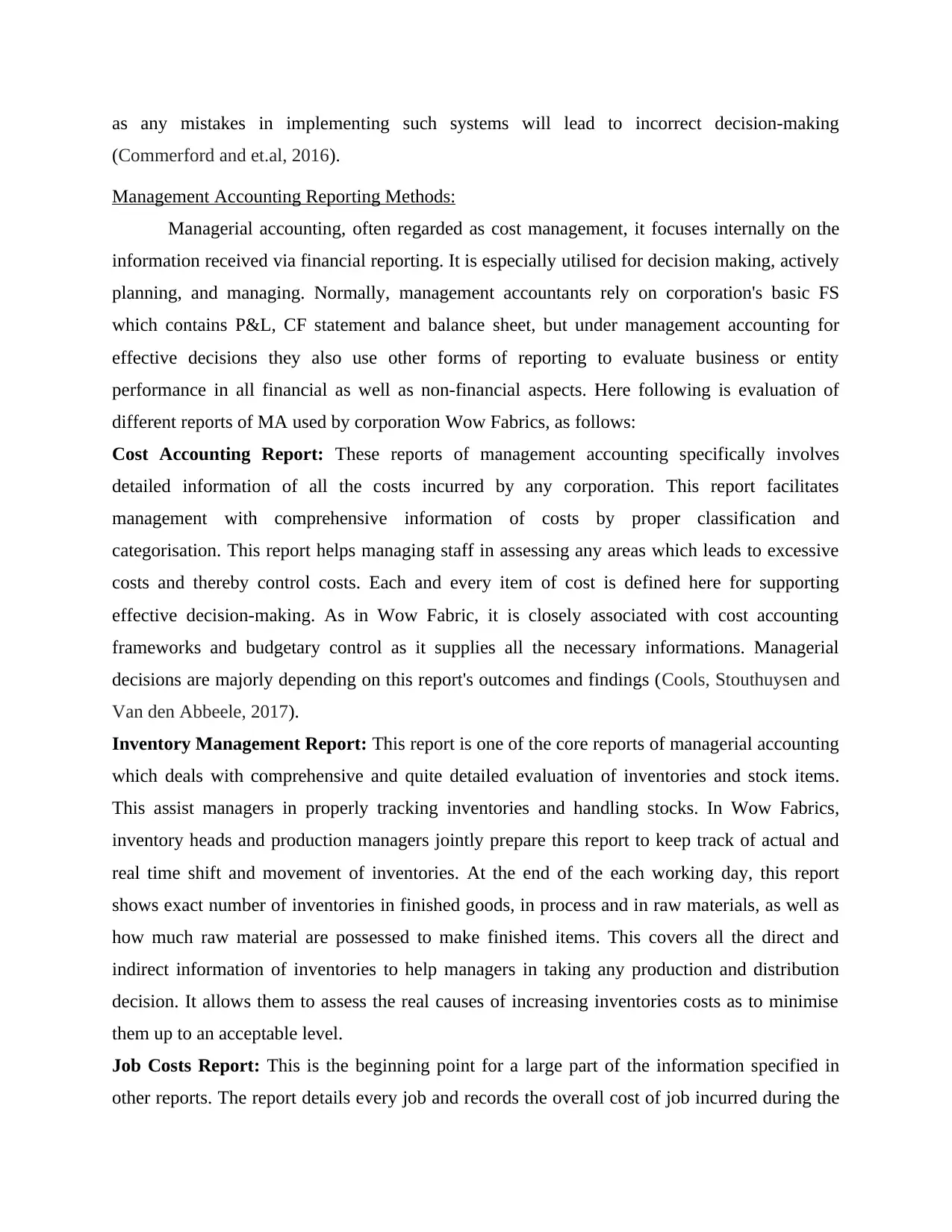
as any mistakes in implementing such systems will lead to incorrect decision-making
(Commerford and et.al, 2016).
Management Accounting Reporting Methods:
Managerial accounting, often regarded as cost management, it focuses internally on the
information received via financial reporting. It is especially utilised for decision making, actively
planning, and managing. Normally, management accountants rely on corporation's basic FS
which contains P&L, CF statement and balance sheet, but under management accounting for
effective decisions they also use other forms of reporting to evaluate business or entity
performance in all financial as well as non-financial aspects. Here following is evaluation of
different reports of MA used by corporation Wow Fabrics, as follows:
Cost Accounting Report: These reports of management accounting specifically involves
detailed information of all the costs incurred by any corporation. This report facilitates
management with comprehensive information of costs by proper classification and
categorisation. This report helps managing staff in assessing any areas which leads to excessive
costs and thereby control costs. Each and every item of cost is defined here for supporting
effective decision-making. As in Wow Fabric, it is closely associated with cost accounting
frameworks and budgetary control as it supplies all the necessary informations. Managerial
decisions are majorly depending on this report's outcomes and findings (Cools, Stouthuysen and
Van den Abbeele, 2017).
Inventory Management Report: This report is one of the core reports of managerial accounting
which deals with comprehensive and quite detailed evaluation of inventories and stock items.
This assist managers in properly tracking inventories and handling stocks. In Wow Fabrics,
inventory heads and production managers jointly prepare this report to keep track of actual and
real time shift and movement of inventories. At the end of the each working day, this report
shows exact number of inventories in finished goods, in process and in raw materials, as well as
how much raw material are possessed to make finished items. This covers all the direct and
indirect information of inventories to help managers in taking any production and distribution
decision. It allows them to assess the real causes of increasing inventories costs as to minimise
them up to an acceptable level.
Job Costs Report: This is the beginning point for a large part of the information specified in
other reports. The report details every job and records the overall cost of job incurred during the
(Commerford and et.al, 2016).
Management Accounting Reporting Methods:
Managerial accounting, often regarded as cost management, it focuses internally on the
information received via financial reporting. It is especially utilised for decision making, actively
planning, and managing. Normally, management accountants rely on corporation's basic FS
which contains P&L, CF statement and balance sheet, but under management accounting for
effective decisions they also use other forms of reporting to evaluate business or entity
performance in all financial as well as non-financial aspects. Here following is evaluation of
different reports of MA used by corporation Wow Fabrics, as follows:
Cost Accounting Report: These reports of management accounting specifically involves
detailed information of all the costs incurred by any corporation. This report facilitates
management with comprehensive information of costs by proper classification and
categorisation. This report helps managing staff in assessing any areas which leads to excessive
costs and thereby control costs. Each and every item of cost is defined here for supporting
effective decision-making. As in Wow Fabric, it is closely associated with cost accounting
frameworks and budgetary control as it supplies all the necessary informations. Managerial
decisions are majorly depending on this report's outcomes and findings (Cools, Stouthuysen and
Van den Abbeele, 2017).
Inventory Management Report: This report is one of the core reports of managerial accounting
which deals with comprehensive and quite detailed evaluation of inventories and stock items.
This assist managers in properly tracking inventories and handling stocks. In Wow Fabrics,
inventory heads and production managers jointly prepare this report to keep track of actual and
real time shift and movement of inventories. At the end of the each working day, this report
shows exact number of inventories in finished goods, in process and in raw materials, as well as
how much raw material are possessed to make finished items. This covers all the direct and
indirect information of inventories to help managers in taking any production and distribution
decision. It allows them to assess the real causes of increasing inventories costs as to minimise
them up to an acceptable level.
Job Costs Report: This is the beginning point for a large part of the information specified in
other reports. The report details every job and records the overall cost of job incurred during the
Paraphrase This Document
Need a fresh take? Get an instant paraphrase of this document with our AI Paraphraser
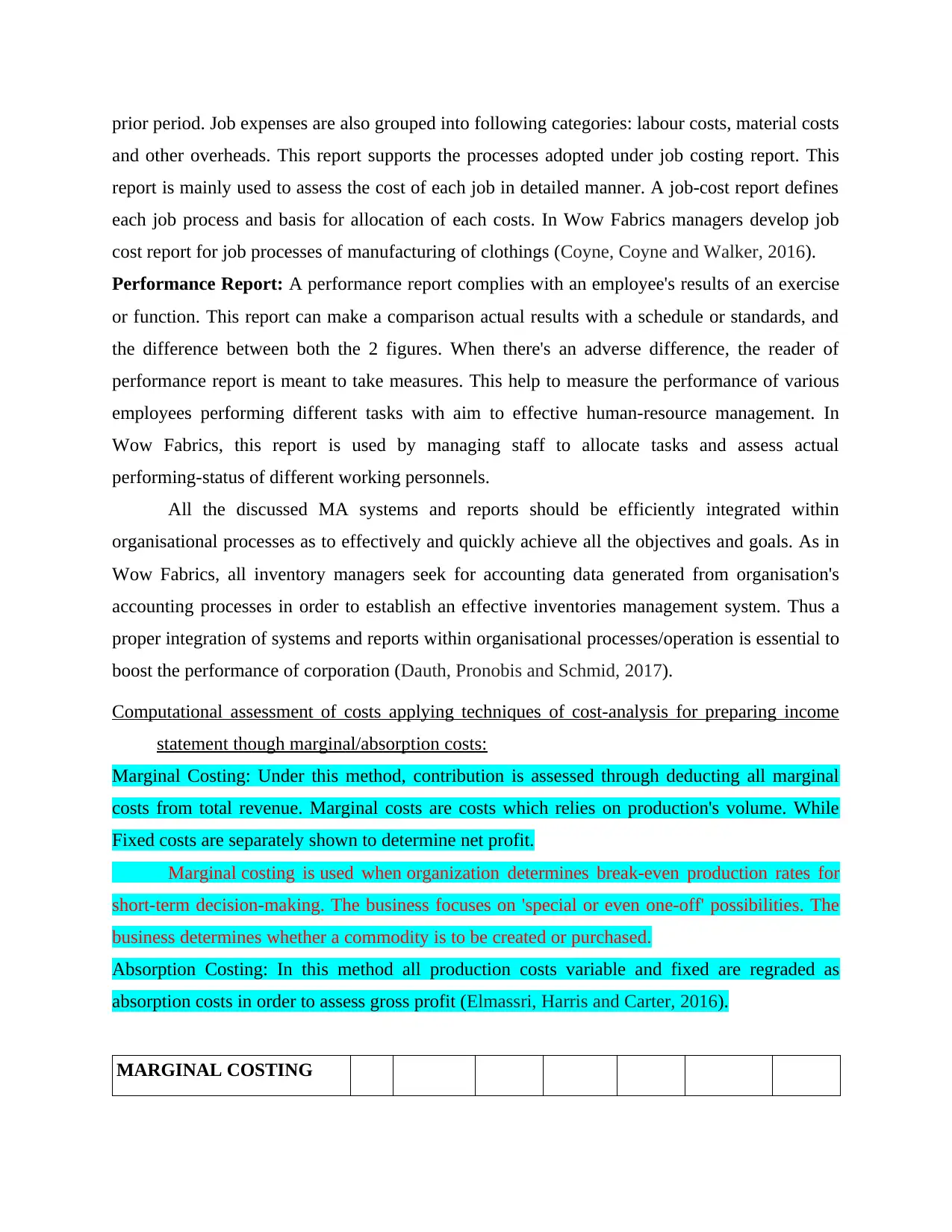
prior period. Job expenses are also grouped into following categories: labour costs, material costs
and other overheads. This report supports the processes adopted under job costing report. This
report is mainly used to assess the cost of each job in detailed manner. A job-cost report defines
each job process and basis for allocation of each costs. In Wow Fabrics managers develop job
cost report for job processes of manufacturing of clothings (Coyne, Coyne and Walker, 2016).
Performance Report: A performance report complies with an employee's results of an exercise
or function. This report can make a comparison actual results with a schedule or standards, and
the difference between both the 2 figures. When there's an adverse difference, the reader of
performance report is meant to take measures. This help to measure the performance of various
employees performing different tasks with aim to effective human-resource management. In
Wow Fabrics, this report is used by managing staff to allocate tasks and assess actual
performing-status of different working personnels.
All the discussed MA systems and reports should be efficiently integrated within
organisational processes as to effectively and quickly achieve all the objectives and goals. As in
Wow Fabrics, all inventory managers seek for accounting data generated from organisation's
accounting processes in order to establish an effective inventories management system. Thus a
proper integration of systems and reports within organisational processes/operation is essential to
boost the performance of corporation (Dauth, Pronobis and Schmid, 2017).
Computational assessment of costs applying techniques of cost-analysis for preparing income
statement though marginal/absorption costs:
Marginal Costing: Under this method, contribution is assessed through deducting all marginal
costs from total revenue. Marginal costs are costs which relies on production's volume. While
Fixed costs are separately shown to determine net profit.
Marginal costing is used when organization determines break-even production rates for
short-term decision-making. The business focuses on 'special or even one-off' possibilities. The
business determines whether a commodity is to be created or purchased.
Absorption Costing: In this method all production costs variable and fixed are regraded as
absorption costs in order to assess gross profit (Elmassri, Harris and Carter, 2016).
MARGINAL COSTING
and other overheads. This report supports the processes adopted under job costing report. This
report is mainly used to assess the cost of each job in detailed manner. A job-cost report defines
each job process and basis for allocation of each costs. In Wow Fabrics managers develop job
cost report for job processes of manufacturing of clothings (Coyne, Coyne and Walker, 2016).
Performance Report: A performance report complies with an employee's results of an exercise
or function. This report can make a comparison actual results with a schedule or standards, and
the difference between both the 2 figures. When there's an adverse difference, the reader of
performance report is meant to take measures. This help to measure the performance of various
employees performing different tasks with aim to effective human-resource management. In
Wow Fabrics, this report is used by managing staff to allocate tasks and assess actual
performing-status of different working personnels.
All the discussed MA systems and reports should be efficiently integrated within
organisational processes as to effectively and quickly achieve all the objectives and goals. As in
Wow Fabrics, all inventory managers seek for accounting data generated from organisation's
accounting processes in order to establish an effective inventories management system. Thus a
proper integration of systems and reports within organisational processes/operation is essential to
boost the performance of corporation (Dauth, Pronobis and Schmid, 2017).
Computational assessment of costs applying techniques of cost-analysis for preparing income
statement though marginal/absorption costs:
Marginal Costing: Under this method, contribution is assessed through deducting all marginal
costs from total revenue. Marginal costs are costs which relies on production's volume. While
Fixed costs are separately shown to determine net profit.
Marginal costing is used when organization determines break-even production rates for
short-term decision-making. The business focuses on 'special or even one-off' possibilities. The
business determines whether a commodity is to be created or purchased.
Absorption Costing: In this method all production costs variable and fixed are regraded as
absorption costs in order to assess gross profit (Elmassri, Harris and Carter, 2016).
MARGINAL COSTING
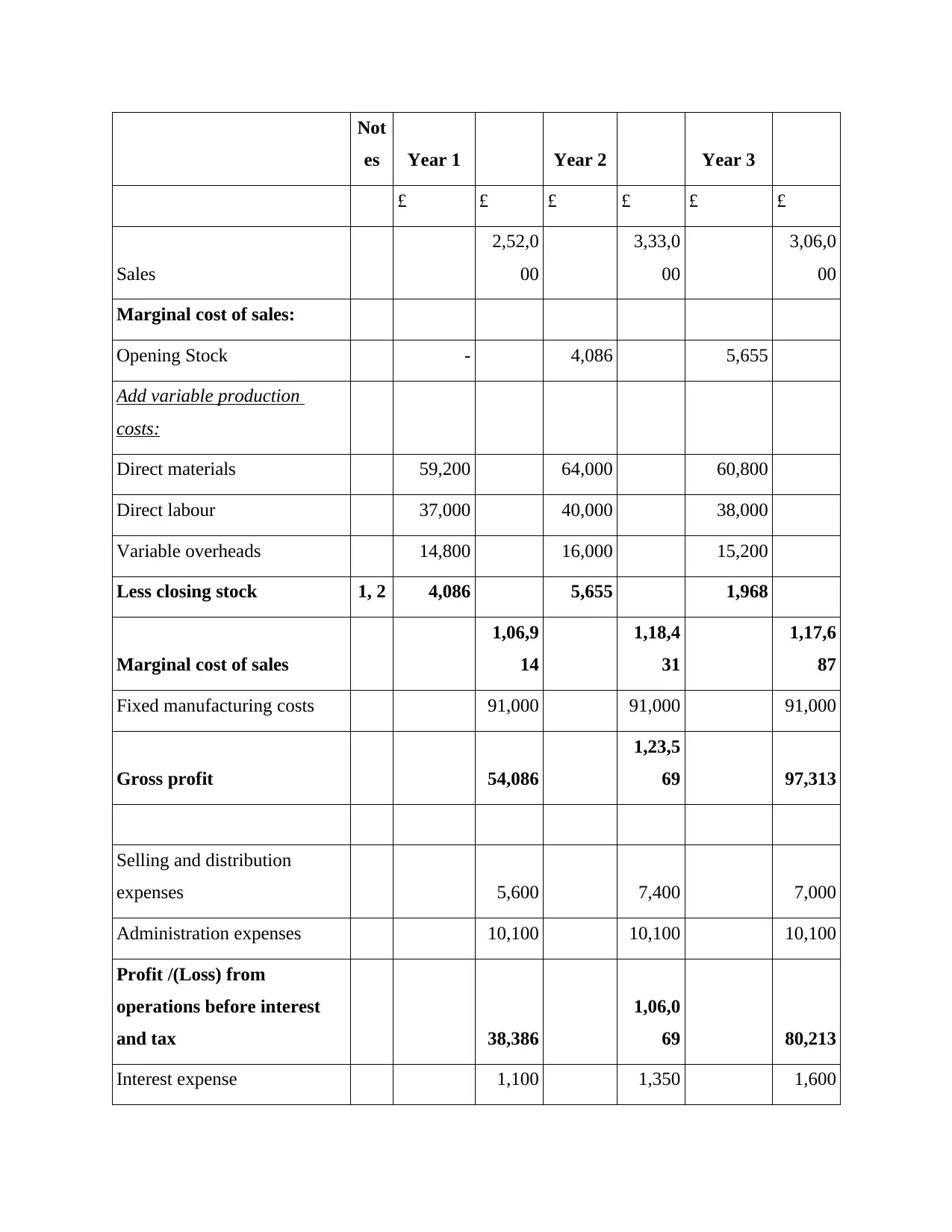
Not
es Year 1 Year 2 Year 3
£ £ £ £ £ £
Sales
2,52,0
00
3,33,0
00
3,06,0
00
Marginal cost of sales:
Opening Stock - 4,086 5,655
Add variable production
costs:
Direct materials 59,200 64,000 60,800
Direct labour 37,000 40,000 38,000
Variable overheads 14,800 16,000 15,200
Less closing stock 1, 2 4,086 5,655 1,968
Marginal cost of sales
1,06,9
14
1,18,4
31
1,17,6
87
Fixed manufacturing costs 91,000 91,000 91,000
Gross profit 54,086
1,23,5
69 97,313
Selling and distribution
expenses 5,600 7,400 7,000
Administration expenses 10,100 10,100 10,100
Profit /(Loss) from
operations before interest
and tax 38,386
1,06,0
69 80,213
Interest expense 1,100 1,350 1,600
es Year 1 Year 2 Year 3
£ £ £ £ £ £
Sales
2,52,0
00
3,33,0
00
3,06,0
00
Marginal cost of sales:
Opening Stock - 4,086 5,655
Add variable production
costs:
Direct materials 59,200 64,000 60,800
Direct labour 37,000 40,000 38,000
Variable overheads 14,800 16,000 15,200
Less closing stock 1, 2 4,086 5,655 1,968
Marginal cost of sales
1,06,9
14
1,18,4
31
1,17,6
87
Fixed manufacturing costs 91,000 91,000 91,000
Gross profit 54,086
1,23,5
69 97,313
Selling and distribution
expenses 5,600 7,400 7,000
Administration expenses 10,100 10,100 10,100
Profit /(Loss) from
operations before interest
and tax 38,386
1,06,0
69 80,213
Interest expense 1,100 1,350 1,600
⊘ This is a preview!⊘
Do you want full access?
Subscribe today to unlock all pages.

Trusted by 1+ million students worldwide
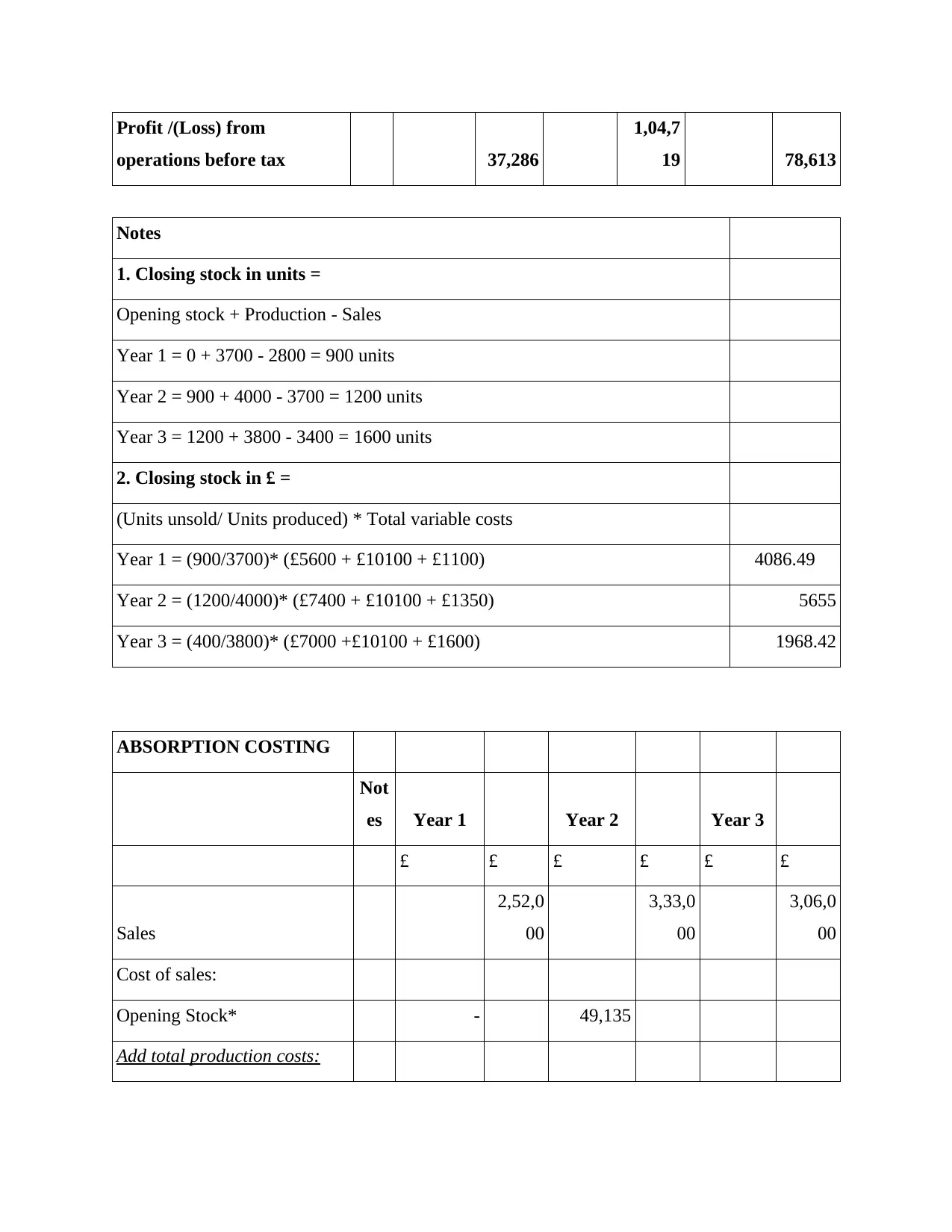
Profit /(Loss) from
operations before tax 37,286
1,04,7
19 78,613
Notes
1. Closing stock in units =
Opening stock + Production - Sales
Year 1 = 0 + 3700 - 2800 = 900 units
Year 2 = 900 + 4000 - 3700 = 1200 units
Year 3 = 1200 + 3800 - 3400 = 1600 units
2. Closing stock in £ =
(Units unsold/ Units produced) * Total variable costs
Year 1 = (900/3700)* (£5600 + £10100 + £1100) 4086.49
Year 2 = (1200/4000)* (£7400 + £10100 + £1350) 5655
Year 3 = (400/3800)* (£7000 +£10100 + £1600) 1968.42
ABSORPTION COSTING
Not
es Year 1 Year 2 Year 3
£ £ £ £ £ £
Sales
2,52,0
00
3,33,0
00
3,06,0
00
Cost of sales:
Opening Stock* - 49,135
Add total production costs:
operations before tax 37,286
1,04,7
19 78,613
Notes
1. Closing stock in units =
Opening stock + Production - Sales
Year 1 = 0 + 3700 - 2800 = 900 units
Year 2 = 900 + 4000 - 3700 = 1200 units
Year 3 = 1200 + 3800 - 3400 = 1600 units
2. Closing stock in £ =
(Units unsold/ Units produced) * Total variable costs
Year 1 = (900/3700)* (£5600 + £10100 + £1100) 4086.49
Year 2 = (1200/4000)* (£7400 + £10100 + £1350) 5655
Year 3 = (400/3800)* (£7000 +£10100 + £1600) 1968.42
ABSORPTION COSTING
Not
es Year 1 Year 2 Year 3
£ £ £ £ £ £
Sales
2,52,0
00
3,33,0
00
3,06,0
00
Cost of sales:
Opening Stock* - 49,135
Add total production costs:
Paraphrase This Document
Need a fresh take? Get an instant paraphrase of this document with our AI Paraphraser
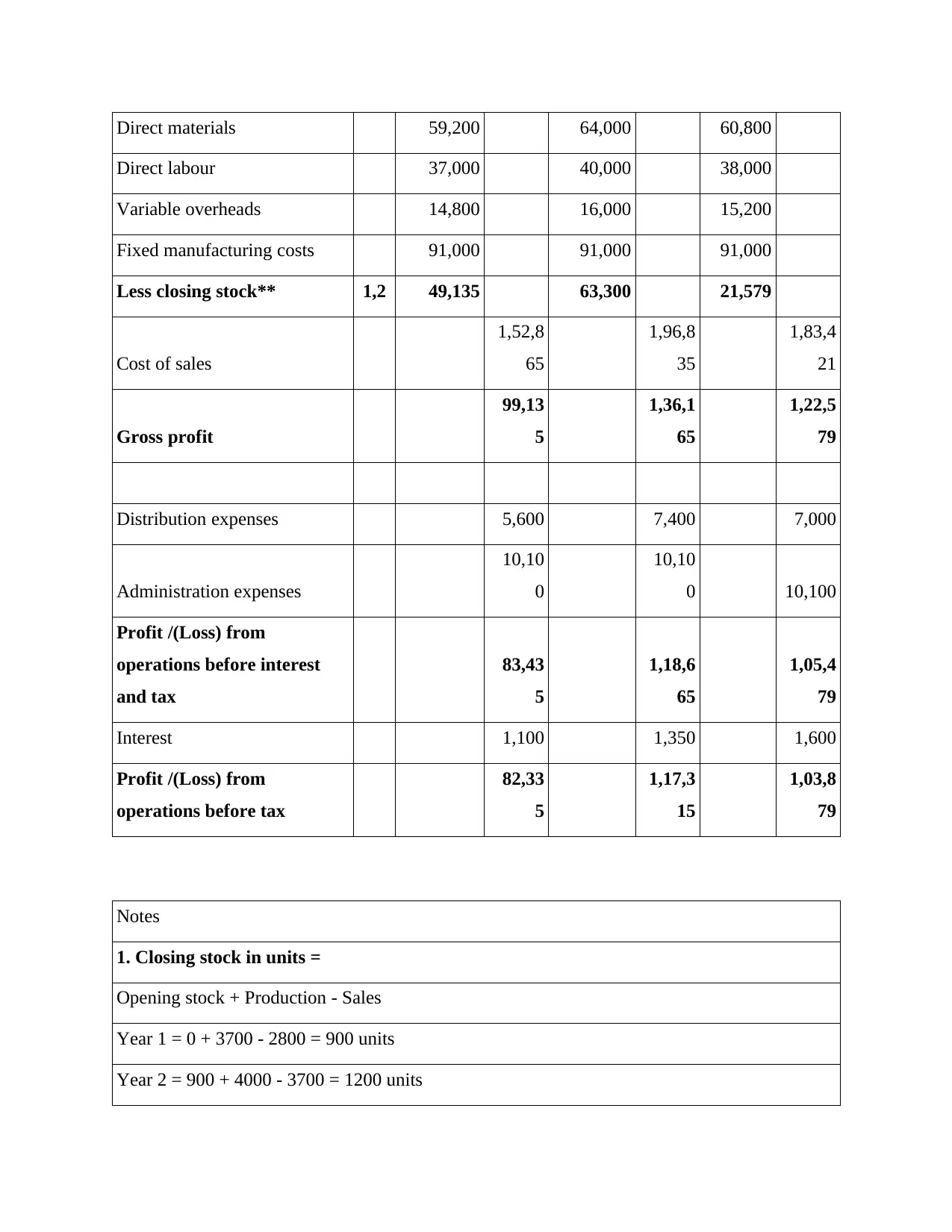
Direct materials 59,200 64,000 60,800
Direct labour 37,000 40,000 38,000
Variable overheads 14,800 16,000 15,200
Fixed manufacturing costs 91,000 91,000 91,000
Less closing stock** 1,2 49,135 63,300 21,579
Cost of sales
1,52,8
65
1,96,8
35
1,83,4
21
Gross profit
99,13
5
1,36,1
65
1,22,5
79
Distribution expenses 5,600 7,400 7,000
Administration expenses
10,10
0
10,10
0 10,100
Profit /(Loss) from
operations before interest
and tax
83,43
5
1,18,6
65
1,05,4
79
Interest 1,100 1,350 1,600
Profit /(Loss) from
operations before tax
82,33
5
1,17,3
15
1,03,8
79
Notes
1. Closing stock in units =
Opening stock + Production - Sales
Year 1 = 0 + 3700 - 2800 = 900 units
Year 2 = 900 + 4000 - 3700 = 1200 units
Direct labour 37,000 40,000 38,000
Variable overheads 14,800 16,000 15,200
Fixed manufacturing costs 91,000 91,000 91,000
Less closing stock** 1,2 49,135 63,300 21,579
Cost of sales
1,52,8
65
1,96,8
35
1,83,4
21
Gross profit
99,13
5
1,36,1
65
1,22,5
79
Distribution expenses 5,600 7,400 7,000
Administration expenses
10,10
0
10,10
0 10,100
Profit /(Loss) from
operations before interest
and tax
83,43
5
1,18,6
65
1,05,4
79
Interest 1,100 1,350 1,600
Profit /(Loss) from
operations before tax
82,33
5
1,17,3
15
1,03,8
79
Notes
1. Closing stock in units =
Opening stock + Production - Sales
Year 1 = 0 + 3700 - 2800 = 900 units
Year 2 = 900 + 4000 - 3700 = 1200 units
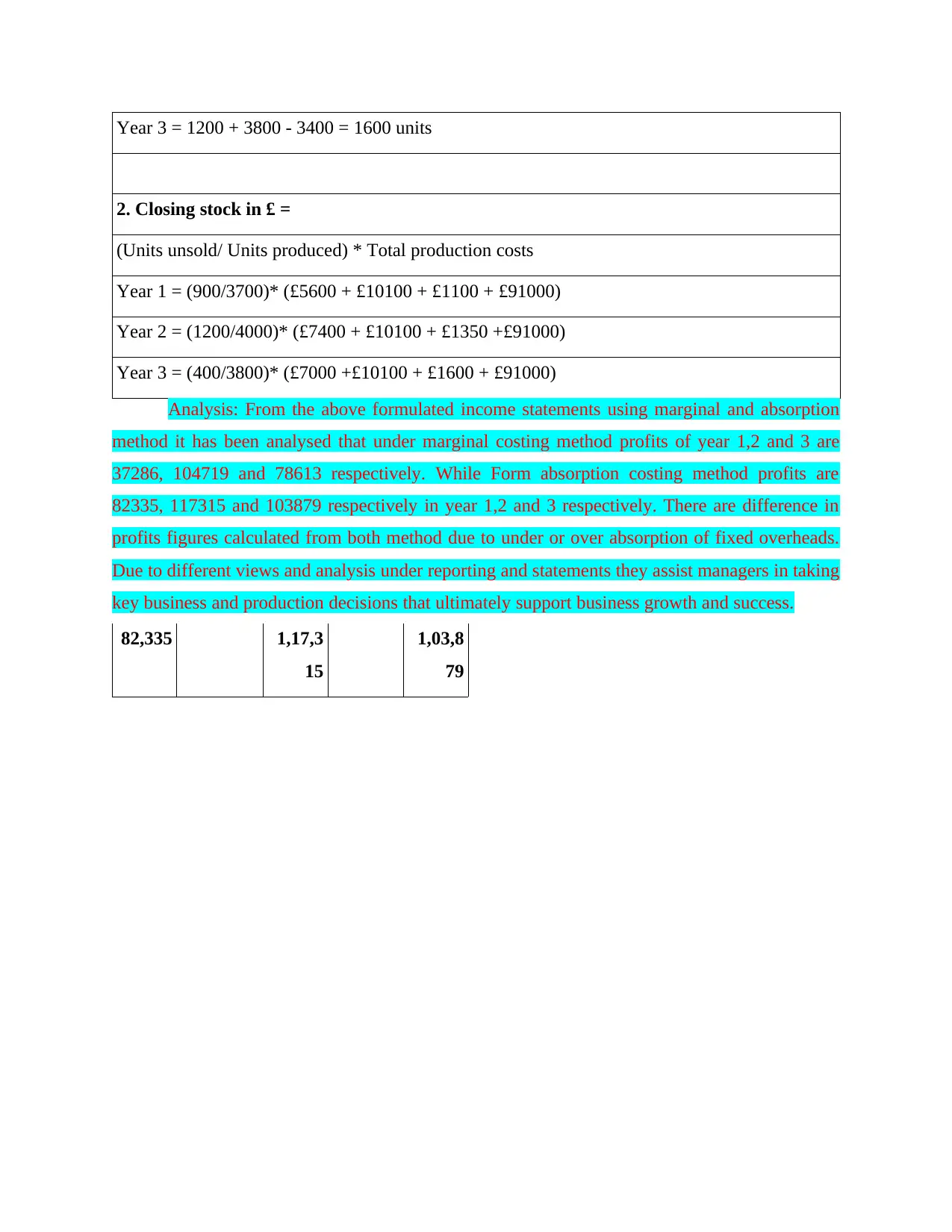
Year 3 = 1200 + 3800 - 3400 = 1600 units
2. Closing stock in £ =
(Units unsold/ Units produced) * Total production costs
Year 1 = (900/3700)* (£5600 + £10100 + £1100 + £91000)
Year 2 = (1200/4000)* (£7400 + £10100 + £1350 +£91000)
Year 3 = (400/3800)* (£7000 +£10100 + £1600 + £91000)
Analysis: From the above formulated income statements using marginal and absorption
method it has been analysed that under marginal costing method profits of year 1,2 and 3 are
37286, 104719 and 78613 respectively. While Form absorption costing method profits are
82335, 117315 and 103879 respectively in year 1,2 and 3 respectively. There are difference in
profits figures calculated from both method due to under or over absorption of fixed overheads.
Due to different views and analysis under reporting and statements they assist managers in taking
key business and production decisions that ultimately support business growth and success.
82,335 1,17,3
15
1,03,8
79
2. Closing stock in £ =
(Units unsold/ Units produced) * Total production costs
Year 1 = (900/3700)* (£5600 + £10100 + £1100 + £91000)
Year 2 = (1200/4000)* (£7400 + £10100 + £1350 +£91000)
Year 3 = (400/3800)* (£7000 +£10100 + £1600 + £91000)
Analysis: From the above formulated income statements using marginal and absorption
method it has been analysed that under marginal costing method profits of year 1,2 and 3 are
37286, 104719 and 78613 respectively. While Form absorption costing method profits are
82335, 117315 and 103879 respectively in year 1,2 and 3 respectively. There are difference in
profits figures calculated from both method due to under or over absorption of fixed overheads.
Due to different views and analysis under reporting and statements they assist managers in taking
key business and production decisions that ultimately support business growth and success.
82,335 1,17,3
15
1,03,8
79
⊘ This is a preview!⊘
Do you want full access?
Subscribe today to unlock all pages.

Trusted by 1+ million students worldwide
1 out of 17
Related Documents
Your All-in-One AI-Powered Toolkit for Academic Success.
+13062052269
info@desklib.com
Available 24*7 on WhatsApp / Email
![[object Object]](/_next/static/media/star-bottom.7253800d.svg)
Unlock your academic potential
Copyright © 2020–2025 A2Z Services. All Rights Reserved. Developed and managed by ZUCOL.





